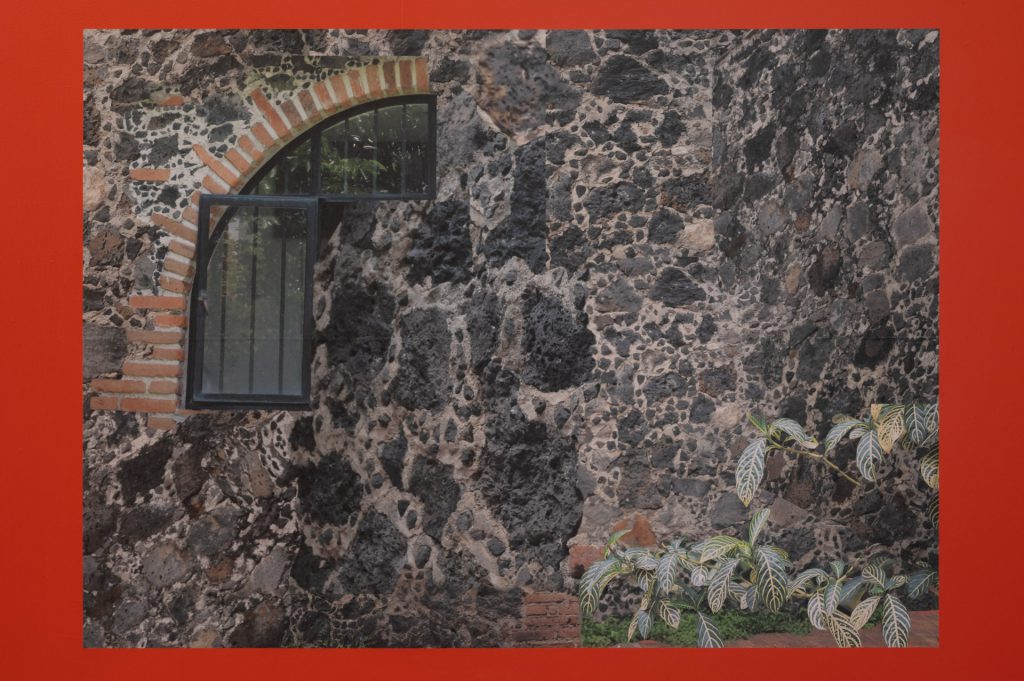A volar entre rocas (To fly between stones) by Mariana Muñoz Gomez
13 June 2022
By Francesca Carella Arfinengo
On a Saturday afternoon in late March of 2021, I get on my bike and head to Blinkers, a DIY project space in the downtown Exchange District of Winnipeg. It is early spring and there is an icy chill on my ears from the wind. It’s my first bike ride of the season, and as I move through the city on two wheels familiar things are seen anew. Dormant muscles are activated; I notice the spring smell of the river, the shadows from bare trees on the path. Two friends and I have booked an appointment to see Mariana Muñoz Gomez’s first solo exhibition, A volar entre rocas (To fly between stones). We are taking advantage of recently eased COVID-19 restrictions, making this visit feel extra special.
The main gallery space features Muñoz Gomez’s installation consisting of digitally manipulated photographs, vinyl text and pieces of Tyndall stone in various shapes and sizes scattered across the gallery. Some walls are painted terracotta orange, a shade close to the ochre pigment of clay, but more vibrant. The colour immediately transports me outside of Winnipeg, where the spring colour palette is limited to beige, grey and brown.
On the walls are five digitally manipulated photographs wheatpasted at various heights. The photographs depict composites of a mosaic stone wall with dark stones stacked on top of each other and mortared together with a light grey material. Each composite consists of many photos of this particular wall, taken in different lighting conditions from different angles and interceded by plants or other objects. The artist manipulates these photos almost like paint, drawing our attention to the physical properties of the stone building material itself. The photographs sit flat on the wall, the thin paper used for printing makes the edges hard to distinguish and play tricks with my vision. My eyes extend the images beyond their frame to all corners of the gallery wall; they become portals to another place.

In the exhibition text, Muñoz Gomez explains that this wall is located in their grandparents’ house in Mexico, where they were born. The building material is a dark volcanic stone from the state of Morelos, primarily used to build structures that symbolize power in precolonial times. When Spanish conquistadors destroyed existing palaces, they built new ones on top of the ruins with the recycled stone. I notice the vinyl text, which is perfectly colour-matched to the terracotta orange of the walls. Imperceptible at first, it reveals itself like a whispered secret, serving as a guide to the installation that provides a descriptive narrative. It reads:
“this limestone has been here for millenia,
absorbing and recording history
like a stone I recall at my grandparents’ house
entre las rocas,
siento que estoy ahí
my grandfather laid them down when there was space between Tlaltenango and Cuernavaca
la ciudad creció y llegaron vecinos
los monasterios en las faldas del Popocatépetl were constructed around the same time
as el Palacio de Cortés, just a few years after
he came to the ‘new world’
as an adult, I learn that Winnipeg used to be
Red River, a largely Métis city
these stones saw the signing of Treaty 1,
a handful of generations ago.”
The limestone referred to in the text is Tyndall, a white stone with mottling in a range of grey tones. Quarried in Manitoba near the towns of Garson and Tyndall, it is also used primarily to build structures that symbolize power.

Muñoz Gomez draws parallels between the histories of domination that have shaped northern and southern parts of North America across time by putting Tyndall and volcanic stone in conversation within the gallery space. In this instance, North America is considered as one geological entity that exists outside colonially imposed borders, a framework for conceiving the land that provides a new perspective to consider the history of all of the Americas, one that centres relations, rather than nations. I think of sillar, a volcanic stone in Arequipa, the city where I was born, which was used by Spaniards to build one of the first colonial cities on the lands of the Quechua and the Aymara. I see sillar as another symbol of dispossessed land and extracted material to assert domination. The pervasiveness of these materials represents the pervasiveness of settler-colonial power: all too familiar, and yet almost invisible.
I wonder about the artist’s choice to feature photographs of the wall in their grandparents’ house, rather than a public building in Mexico. Muñoz Gomez, who is now based in Canada, has tied the establishment of colonial power to their personal history. People built homes while nation-states were being established, and will continue to do so. Muñoz Gomez’s work complicates the idea of history as past and emphasizes the complexities of history in the present moment.
Next I head towards the basement space down some stairs. As I make my way, I look up and notice a picture of the sky wheatpasted to the wall high above my head. Fluffy clouds, the sunlight, soft pink light… travelling. The photograph activates the feeling of being permanently in transit. I think, as a member of the diaspora myself, about how we reside mid-air, in between two places.
The basement space is small and dark with a bench to sit and watch Muñoz Gomez’s video work. The video consists of footage of the artist’s trips to Mexico, collaging casual smartphone videos, intermixed with screen recordings from the process of digitally manipulating the photographs displayed in the main gallery. In the video, Muñoz Gomez has included clips from guided tours, featuring a computer-generated voice that describes a monument or important building. These recordings are meant to be entertaining for tourists, reducing the complexity of historical events into apolitical statements. They are, in essence, cringeworthy, and stand as a good contrast to the complex and more personal narrative the artist shares in the main gallery. These moments are sandwiched between more intimate and serene clips such as a video of a turtle swimming slowly in murky green waters on a sunny day. The artist also includes screen recordings of themselves working on the composite photographs. In this video work there is a push and pull between exploring and remembering, both past and present, and private and public.

The main thread through the works in the exhibition is that they are made of bits and pieces. Maybe this method of working comes from a diasporic ethos—the diaspora has lost access to a lot of information. When we contend with our identity, we do so by calling upon concealed histories, a lack of access to historical records and the memories of ourselves and our family, distorted by time. In this context the work in A volar entre rocas comes from movement: it is by navigating the land of so-called Canada and Mexico that the artist has formed the concept of the show. The work shown comes from embodied knowledge and, as a viewer, it feels like a real privilege to witness this artwork in person, experiencing it through my own body.
Muñoz Gomez, and the work in this exhibition, express a poetic understanding of transnational identity that brings national borders into question. The work considers stones as witnesses of human activity, challenging our understanding of inanimate construction materials and presenting them as symbols of colonial power. As I exit the gallery I feel transported elsewhere (perhaps back home?) and I reflect on the complex history of my ancestors and how this intersects with my own immigration to Canada. I get on my bike and ride on stolen land as a first-generation Latine settler. The movement activates my imagination and I dream of futures of abundance and co-operation, where domination and extractivism are no longer the main narratives.
A volar entre rocas (To fly between stones) ran from February 20 – April 18, 2021 at Blinkers Art + Projects in Winnipeg, MB.
Feature Image: Image: Installation view of A volar entre rocas, 2021 by Mariana Muñoz Gomez. Photo courtesy of Blinkers Art + Projects.



